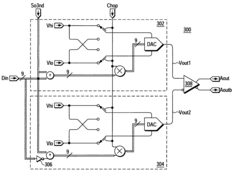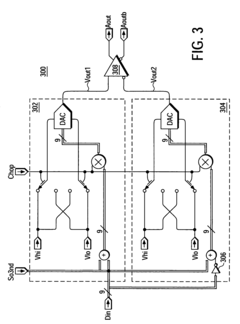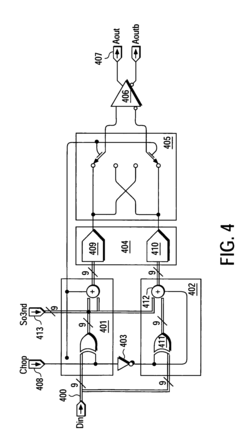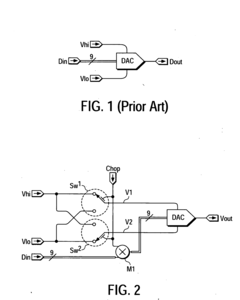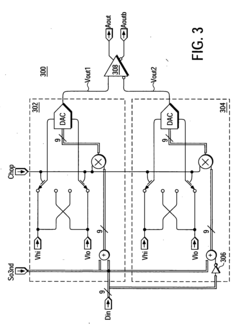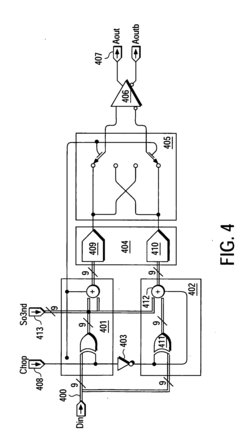LDAC and Its Utility in High-End Audio Equipment
JUL 4, 20258 MIN READ
Generate Your Research Report Instantly with AI Agent
Patsnap Eureka helps you evaluate technical feasibility & market potential.
LDAC Technology Overview
LDAC, developed by Sony in 2015, is a proprietary audio coding technology designed to deliver high-resolution audio over Bluetooth connections. This innovative technology aims to address the limitations of traditional Bluetooth audio codecs, which often compromise audio quality due to bandwidth constraints. LDAC operates by employing a sophisticated encoding algorithm that allows for the transmission of audio data at up to 990 kbps, significantly higher than the standard SBC codec used in most Bluetooth audio devices.
The core principle behind LDAC is its adaptive bit rate system, which dynamically adjusts the data transmission rate based on the wireless environment and device capabilities. This flexibility enables LDAC to maintain optimal audio quality across various scenarios, from ideal conditions to more challenging environments with potential interference. The technology supports three audio quality modes: 330 kbps, 660 kbps, and 990 kbps, allowing users to prioritize either audio fidelity or connection stability as needed.
One of LDAC's key features is its ability to transmit 24-bit/96 kHz audio content, which is considered high-resolution audio. This capability sets LDAC apart from many other Bluetooth codecs, as it can theoretically preserve more of the original audio information during wireless transmission. The technology achieves this by utilizing advanced psychoacoustic modeling and efficient data compression techniques, minimizing the loss of audio quality typically associated with Bluetooth streaming.
In the context of high-end audio equipment, LDAC offers several advantages. Firstly, it enables wireless audio systems to approach the quality of wired connections, a long-standing challenge in the audiophile community. This breakthrough allows for greater flexibility in system setup without sacrificing audio fidelity. Secondly, LDAC's support for high-resolution audio formats aligns well with the increasing availability of high-quality digital music sources, catering to the demands of discerning listeners.
Furthermore, LDAC's integration into the Android operating system since version 8.0 has significantly expanded its accessibility, making it a viable option for a wide range of audio devices beyond Sony's ecosystem. This broader adoption has led to increased interest from high-end audio manufacturers, who see LDAC as a means to enhance the wireless capabilities of their products without compromising on sound quality.
However, it's important to note that while LDAC represents a significant advancement in Bluetooth audio technology, its effectiveness is still subject to various factors, including the quality of the audio source, the capabilities of the transmitting and receiving devices, and the overall Bluetooth signal strength. As such, the implementation of LDAC in high-end audio equipment requires careful consideration of these factors to fully realize its potential benefits.
The core principle behind LDAC is its adaptive bit rate system, which dynamically adjusts the data transmission rate based on the wireless environment and device capabilities. This flexibility enables LDAC to maintain optimal audio quality across various scenarios, from ideal conditions to more challenging environments with potential interference. The technology supports three audio quality modes: 330 kbps, 660 kbps, and 990 kbps, allowing users to prioritize either audio fidelity or connection stability as needed.
One of LDAC's key features is its ability to transmit 24-bit/96 kHz audio content, which is considered high-resolution audio. This capability sets LDAC apart from many other Bluetooth codecs, as it can theoretically preserve more of the original audio information during wireless transmission. The technology achieves this by utilizing advanced psychoacoustic modeling and efficient data compression techniques, minimizing the loss of audio quality typically associated with Bluetooth streaming.
In the context of high-end audio equipment, LDAC offers several advantages. Firstly, it enables wireless audio systems to approach the quality of wired connections, a long-standing challenge in the audiophile community. This breakthrough allows for greater flexibility in system setup without sacrificing audio fidelity. Secondly, LDAC's support for high-resolution audio formats aligns well with the increasing availability of high-quality digital music sources, catering to the demands of discerning listeners.
Furthermore, LDAC's integration into the Android operating system since version 8.0 has significantly expanded its accessibility, making it a viable option for a wide range of audio devices beyond Sony's ecosystem. This broader adoption has led to increased interest from high-end audio manufacturers, who see LDAC as a means to enhance the wireless capabilities of their products without compromising on sound quality.
However, it's important to note that while LDAC represents a significant advancement in Bluetooth audio technology, its effectiveness is still subject to various factors, including the quality of the audio source, the capabilities of the transmitting and receiving devices, and the overall Bluetooth signal strength. As such, the implementation of LDAC in high-end audio equipment requires careful consideration of these factors to fully realize its potential benefits.
High-End Audio Market Analysis
The high-end audio market has experienced significant growth in recent years, driven by increasing consumer demand for premium sound quality and immersive audio experiences. This segment caters to audiophiles, music enthusiasts, and professionals who seek superior audio reproduction and are willing to invest in high-performance equipment.
Market research indicates that the global high-end audio market is expected to continue its upward trajectory, with a compound annual growth rate (CAGR) projected to exceed 7% over the next five years. This growth is attributed to several factors, including rising disposable incomes, technological advancements in audio equipment, and a growing appreciation for high-fidelity sound among consumers.
The market for high-end audio equipment encompasses various product categories, including speakers, amplifiers, digital-to-analog converters (DACs), headphones, and streaming devices. Among these, wireless audio solutions have gained substantial traction, with consumers increasingly seeking convenience without compromising on sound quality. This trend has led to the development of advanced wireless audio codecs like LDAC, which aims to bridge the gap between wireless convenience and audiophile-grade performance.
Geographically, North America and Europe remain the largest markets for high-end audio equipment, accounting for a significant portion of global sales. However, the Asia-Pacific region, particularly countries like China and Japan, is emerging as a rapidly growing market, driven by a burgeoning middle class and a strong cultural affinity for advanced technology.
The competitive landscape of the high-end audio market is characterized by a mix of established legacy brands and innovative newcomers. Traditional audiophile brands continue to maintain a strong presence, leveraging their reputation for quality and craftsmanship. Simultaneously, tech-focused companies are entering the market, introducing products that integrate cutting-edge digital technologies with high-fidelity audio reproduction.
Consumer preferences in the high-end audio segment are evolving, with a growing emphasis on multi-room audio systems, smart home integration, and high-resolution audio formats. This shift is driving manufacturers to develop products that not only deliver exceptional sound quality but also offer seamless connectivity and compatibility with various digital ecosystems.
The adoption of advanced audio codecs like LDAC in high-end equipment represents a significant trend, addressing the increasing demand for wireless solutions that can deliver near-lossless audio quality. This technology is particularly relevant in the context of high-resolution audio streaming services, which are gaining popularity among audiophiles and contributing to the overall growth of the high-end audio market.
Market research indicates that the global high-end audio market is expected to continue its upward trajectory, with a compound annual growth rate (CAGR) projected to exceed 7% over the next five years. This growth is attributed to several factors, including rising disposable incomes, technological advancements in audio equipment, and a growing appreciation for high-fidelity sound among consumers.
The market for high-end audio equipment encompasses various product categories, including speakers, amplifiers, digital-to-analog converters (DACs), headphones, and streaming devices. Among these, wireless audio solutions have gained substantial traction, with consumers increasingly seeking convenience without compromising on sound quality. This trend has led to the development of advanced wireless audio codecs like LDAC, which aims to bridge the gap between wireless convenience and audiophile-grade performance.
Geographically, North America and Europe remain the largest markets for high-end audio equipment, accounting for a significant portion of global sales. However, the Asia-Pacific region, particularly countries like China and Japan, is emerging as a rapidly growing market, driven by a burgeoning middle class and a strong cultural affinity for advanced technology.
The competitive landscape of the high-end audio market is characterized by a mix of established legacy brands and innovative newcomers. Traditional audiophile brands continue to maintain a strong presence, leveraging their reputation for quality and craftsmanship. Simultaneously, tech-focused companies are entering the market, introducing products that integrate cutting-edge digital technologies with high-fidelity audio reproduction.
Consumer preferences in the high-end audio segment are evolving, with a growing emphasis on multi-room audio systems, smart home integration, and high-resolution audio formats. This shift is driving manufacturers to develop products that not only deliver exceptional sound quality but also offer seamless connectivity and compatibility with various digital ecosystems.
The adoption of advanced audio codecs like LDAC in high-end equipment represents a significant trend, addressing the increasing demand for wireless solutions that can deliver near-lossless audio quality. This technology is particularly relevant in the context of high-resolution audio streaming services, which are gaining popularity among audiophiles and contributing to the overall growth of the high-end audio market.
LDAC Technical Challenges
LDAC, as a cutting-edge audio codec technology, faces several technical challenges in its implementation and optimization for high-end audio equipment. One of the primary challenges is maintaining high-quality audio transmission while operating within the constraints of Bluetooth bandwidth limitations. The codec must compress audio data efficiently without compromising the integrity of the original sound, which becomes increasingly difficult as audio resolution and bit depth increase.
Another significant challenge lies in the real-time encoding and decoding processes. LDAC needs to perform complex calculations to compress and decompress audio data with minimal latency, ensuring a seamless listening experience. This requires substantial processing power, which can be a limiting factor in portable devices with limited battery capacity and thermal constraints.
The adaptive bitrate feature of LDAC, while beneficial for maintaining stable connections, presents its own set of challenges. The codec must dynamically adjust its compression algorithms based on the available bandwidth, all while maintaining consistent audio quality. This requires sophisticated decision-making algorithms that can rapidly assess network conditions and adjust encoding parameters accordingly.
Interoperability is another crucial challenge for LDAC. As a proprietary technology developed by Sony, ensuring compatibility with a wide range of devices and audio systems can be complex. This includes not only hardware compatibility but also software integration with various operating systems and audio processing chains.
Power consumption is a critical concern, particularly for battery-powered devices. The complex processing required for LDAC encoding and decoding can be energy-intensive, potentially impacting the battery life of portable audio equipment. Balancing high-quality audio transmission with energy efficiency remains an ongoing challenge for LDAC implementation.
Furthermore, the pursuit of even higher audio quality presents continuous challenges. As consumer expectations for audio fidelity increase, LDAC must evolve to support higher sampling rates and bit depths while maintaining efficient data transmission. This push for higher quality audio within the constraints of wireless technology requires ongoing research and development.
Lastly, the challenge of reducing audio artifacts and distortions inherent to lossy compression techniques is ever-present. While LDAC performs admirably in this regard, there is always room for improvement in minimizing perceptible differences between the original audio source and the transmitted signal, especially for discerning audiophiles using high-end equipment.
Another significant challenge lies in the real-time encoding and decoding processes. LDAC needs to perform complex calculations to compress and decompress audio data with minimal latency, ensuring a seamless listening experience. This requires substantial processing power, which can be a limiting factor in portable devices with limited battery capacity and thermal constraints.
The adaptive bitrate feature of LDAC, while beneficial for maintaining stable connections, presents its own set of challenges. The codec must dynamically adjust its compression algorithms based on the available bandwidth, all while maintaining consistent audio quality. This requires sophisticated decision-making algorithms that can rapidly assess network conditions and adjust encoding parameters accordingly.
Interoperability is another crucial challenge for LDAC. As a proprietary technology developed by Sony, ensuring compatibility with a wide range of devices and audio systems can be complex. This includes not only hardware compatibility but also software integration with various operating systems and audio processing chains.
Power consumption is a critical concern, particularly for battery-powered devices. The complex processing required for LDAC encoding and decoding can be energy-intensive, potentially impacting the battery life of portable audio equipment. Balancing high-quality audio transmission with energy efficiency remains an ongoing challenge for LDAC implementation.
Furthermore, the pursuit of even higher audio quality presents continuous challenges. As consumer expectations for audio fidelity increase, LDAC must evolve to support higher sampling rates and bit depths while maintaining efficient data transmission. This push for higher quality audio within the constraints of wireless technology requires ongoing research and development.
Lastly, the challenge of reducing audio artifacts and distortions inherent to lossy compression techniques is ever-present. While LDAC performs admirably in this regard, there is always room for improvement in minimizing perceptible differences between the original audio source and the transmitted signal, especially for discerning audiophiles using high-end equipment.
Current LDAC Implementations
01 LDAC codec implementation for high-quality audio transmission
LDAC is a high-resolution audio codec developed for Bluetooth audio transmission. It enables the transmission of high-quality audio data at higher bit rates compared to standard Bluetooth codecs. LDAC supports various sampling rates and bit depths, allowing for near lossless audio quality in wireless audio devices.- LDAC codec implementation for high-quality audio transmission: LDAC is a high-resolution audio codec developed for Bluetooth audio transmission. It enables the transmission of high-quality audio data at higher bit rates compared to standard Bluetooth codecs. The implementation of LDAC in audio devices allows for improved audio quality, wider frequency range, and better dynamic range in wireless audio streaming.
- Audio signal processing for LDAC optimization: Various signal processing techniques are employed to optimize LDAC audio quality. These may include advanced digital signal processing algorithms, adaptive bit rate allocation, and efficient encoding/decoding methods. Such techniques aim to maximize the audio quality within the constraints of wireless transmission, ensuring optimal performance of the LDAC codec.
- Integration of LDAC with audio playback systems: LDAC technology is integrated into various audio playback systems, including smartphones, wireless headphones, and home audio systems. This integration involves hardware and software implementations to ensure compatibility and optimal performance of LDAC-encoded audio across different devices and platforms.
- Quality assessment and enhancement of LDAC audio: Methods for assessing and enhancing the quality of LDAC-encoded audio are developed. These may include objective quality metrics, perceptual audio quality evaluation techniques, and adaptive enhancement algorithms. Such methods help in maintaining and improving the audio quality in various listening environments and device configurations.
- Network and transmission optimization for LDAC: Techniques for optimizing network conditions and transmission protocols for LDAC audio are implemented. These may include adaptive streaming methods, error correction techniques, and bandwidth management strategies. Such optimizations aim to ensure stable and high-quality LDAC audio transmission over various network conditions and Bluetooth connections.
02 Audio quality enhancement through signal processing
Various signal processing techniques are employed to enhance audio quality in LDAC-enabled devices. These may include noise reduction, dynamic range compression, and equalization. Advanced algorithms are used to optimize the audio signal before encoding and after decoding, ensuring the best possible sound quality within the constraints of wireless transmission.Expand Specific Solutions03 Adaptive bit rate and connection stability
LDAC incorporates adaptive bit rate technology to maintain a stable connection and optimal audio quality. The system can dynamically adjust the bit rate based on the wireless connection quality, ensuring consistent performance even in challenging environments. This adaptive approach helps balance audio quality with connection stability.Expand Specific Solutions04 Integration with audio playback devices and systems
LDAC technology is integrated into various audio playback devices and systems, including smartphones, wireless headphones, and home audio systems. This integration involves hardware and software optimizations to ensure compatibility and maximize the benefits of high-quality audio transmission. Manufacturers implement LDAC support in their products to offer enhanced audio experiences to consumers.Expand Specific Solutions05 User experience and audio quality perception
The implementation of LDAC technology aims to improve the overall user experience by providing high-quality audio. This includes considerations for subjective audio quality perception, user interface design for audio settings, and the ability to switch between different audio quality modes. The goal is to deliver a noticeable improvement in audio fidelity that enhances the listening experience for users.Expand Specific Solutions
Key LDAC Industry Players
The LDAC (Low Latency and High-Quality Audio Codec) technology market is in a growth phase, with increasing adoption in high-end audio equipment. The market size is expanding as consumer demand for superior audio quality rises. Technologically, LDAC is maturing, with major players like Sony (developer of LDAC), Qualcomm, and Samsung Electronics leading innovation. Companies such as Harman Becker Automotive Systems and ROHM Co., Ltd. are integrating LDAC into their audio solutions, while semiconductor firms like Texas Instruments and Analog Devices are supporting its implementation. The competitive landscape is characterized by a mix of established electronics giants and specialized audio technology firms, driving continuous improvements in audio codec performance and efficiency.
QUALCOMM, Inc.
Technical Solution: Qualcomm has been at the forefront of LDAC technology implementation in mobile devices. Their Snapdragon Sound technology incorporates LDAC to deliver high-resolution audio wirelessly. Qualcomm's approach focuses on optimizing LDAC for mobile platforms, ensuring efficient power consumption while maintaining audio quality. They have achieved LDAC transmission rates of up to 990 kbps[1], allowing for near lossless audio streaming. Qualcomm has also worked on improving LDAC's compatibility with various Bluetooth audio devices, enhancing its utility in the high-end audio equipment market[2].
Strengths: Wide adoption in mobile devices, optimized power consumption. Weaknesses: Dependent on device manufacturers for implementation, limited control over end-user experience.
Samsung Electronics Co., Ltd.
Technical Solution: Samsung has integrated LDAC technology into its Galaxy series smartphones and wearables, positioning it as a key feature for audiophiles. Their implementation focuses on seamless integration with their ecosystem of devices, including Galaxy Buds and other audio accessories. Samsung has worked on optimizing LDAC performance in challenging wireless environments, improving connection stability and reducing dropouts[3]. They have also developed adaptive bit rate algorithms that dynamically adjust LDAC transmission rates based on network conditions, ensuring consistent audio quality[4].
Strengths: Ecosystem integration, adaptive performance optimization. Weaknesses: Limited to Samsung devices, potential interoperability issues with non-Samsung products.
LDAC Core Patents Analysis
Audio digital to analog converter with harmonic suppression
PatentInactiveUS6987475B2
Innovation
- The solution involves using digital signal processing techniques to correct errors in low-end DACs by reversing the roles of signal bounds and negating the input signal, combined with a sinusoidal common mode signal to suppress both even and odd harmonics, effectively moving error terms out of the frequency band.
Audio digital to analog converter with harmonic suppression
PatentInactiveUS20050219104A1
Innovation
- The use of digital signal processing techniques to correct errors in low-end DACs by reversing signal roles and applying a chopping frequency to move even harmonics out of the frequency band, combined with a sinusoidal common mode signal to suppress odd harmonics, effectively reducing harmonic distortion.
Audio Codec Comparison
LDAC, developed by Sony, stands out as a high-resolution audio codec in the competitive landscape of wireless audio transmission technologies. When comparing LDAC to other prominent audio codecs, several key factors come into play, including bit rate, frequency response, and overall audio quality.
LDAC offers a maximum bit rate of 990 kbps, significantly higher than its competitors. In contrast, aptX HD, another high-quality codec, provides a maximum of 576 kbps, while standard Bluetooth SBC typically operates at 328 kbps. This higher bit rate allows LDAC to transmit more audio data, potentially resulting in better sound quality.
Frequency response is another crucial aspect of audio codec performance. LDAC supports a wide frequency range up to 96 kHz, covering the entire audible spectrum and beyond. This surpasses many other codecs, including AAC, which is limited to 22 kHz, and aptX, which reaches 48 kHz.
In terms of audio resolution, LDAC can handle up to 32-bit/96 kHz audio, preserving more detail from high-resolution audio sources. This capability exceeds that of aptX HD, which supports 24-bit/48 kHz, and standard Bluetooth codecs, which are often limited to 16-bit/44.1 kHz.
Latency is a critical factor for audio-visual synchronization. LDAC's latency performance is comparable to other advanced codecs like aptX Low Latency, making it suitable for video content and gaming applications. However, it may not match the ultra-low latency of some specialized gaming codecs.
Compatibility is an area where LDAC faces challenges. While it's widely supported on Android devices, its adoption in non-Sony products is limited compared to more ubiquitous codecs like SBC, AAC, and aptX. This restricted ecosystem can impact its utility in some high-end audio equipment.
Energy efficiency is another consideration. LDAC's high bit rate can lead to increased power consumption compared to lower bit rate codecs, potentially affecting battery life in wireless audio devices.
In real-world listening tests, LDAC often receives praise for its audio quality, particularly in preserving the nuances of high-resolution audio sources. However, the perceptible difference between LDAC and other high-quality codecs like aptX HD can be subtle, especially on consumer-grade equipment or in non-ideal listening environments.
LDAC offers a maximum bit rate of 990 kbps, significantly higher than its competitors. In contrast, aptX HD, another high-quality codec, provides a maximum of 576 kbps, while standard Bluetooth SBC typically operates at 328 kbps. This higher bit rate allows LDAC to transmit more audio data, potentially resulting in better sound quality.
Frequency response is another crucial aspect of audio codec performance. LDAC supports a wide frequency range up to 96 kHz, covering the entire audible spectrum and beyond. This surpasses many other codecs, including AAC, which is limited to 22 kHz, and aptX, which reaches 48 kHz.
In terms of audio resolution, LDAC can handle up to 32-bit/96 kHz audio, preserving more detail from high-resolution audio sources. This capability exceeds that of aptX HD, which supports 24-bit/48 kHz, and standard Bluetooth codecs, which are often limited to 16-bit/44.1 kHz.
Latency is a critical factor for audio-visual synchronization. LDAC's latency performance is comparable to other advanced codecs like aptX Low Latency, making it suitable for video content and gaming applications. However, it may not match the ultra-low latency of some specialized gaming codecs.
Compatibility is an area where LDAC faces challenges. While it's widely supported on Android devices, its adoption in non-Sony products is limited compared to more ubiquitous codecs like SBC, AAC, and aptX. This restricted ecosystem can impact its utility in some high-end audio equipment.
Energy efficiency is another consideration. LDAC's high bit rate can lead to increased power consumption compared to lower bit rate codecs, potentially affecting battery life in wireless audio devices.
In real-world listening tests, LDAC often receives praise for its audio quality, particularly in preserving the nuances of high-resolution audio sources. However, the perceptible difference between LDAC and other high-quality codecs like aptX HD can be subtle, especially on consumer-grade equipment or in non-ideal listening environments.
LDAC Ecosystem Integration
The integration of LDAC into the high-end audio ecosystem has been a significant development in recent years. LDAC, developed by Sony, has become a key technology in the wireless audio transmission landscape, particularly for high-resolution audio content. Its adoption by various manufacturers has led to a growing ecosystem of compatible devices and services.
At the core of the LDAC ecosystem are the source devices, primarily smartphones and digital audio players. Many Android devices now support LDAC natively, thanks to its inclusion in the Android Open Source Project (AOSP) since Android 8.0. This wide availability has significantly expanded the potential user base for LDAC-enabled audio products.
On the receiving end, a diverse range of audio devices now incorporate LDAC technology. These include wireless headphones, earbuds, speakers, and home audio systems. Major audio brands such as Sony, Audio-Technica, and Fiio have embraced LDAC in their premium product lines, recognizing its ability to deliver superior audio quality over Bluetooth connections.
The LDAC ecosystem extends beyond hardware to include software and content providers. Music streaming services play a crucial role in this ecosystem, with platforms like Tidal and Amazon Music HD offering high-resolution audio tracks that can fully utilize LDAC's capabilities. These services have helped drive consumer demand for high-quality wireless audio experiences.
Audio processing software and apps have also emerged to support LDAC technology. These tools allow users to optimize their audio settings, manage LDAC connections, and even analyze the quality of their wireless audio transmissions. Such software enhances the user experience and helps audiophiles maximize the potential of their LDAC-enabled setups.
The integration of LDAC into professional audio equipment has further expanded its ecosystem. Recording studios and live sound reinforcement systems are beginning to adopt LDAC for monitoring and playback purposes, appreciating its low latency and high-quality transmission characteristics.
As the LDAC ecosystem continues to grow, interoperability between devices from different manufacturers has become increasingly important. Industry collaborations and standardization efforts are underway to ensure seamless compatibility across the LDAC ecosystem, enhancing the technology's appeal to both consumers and audio professionals.
The expansion of the LDAC ecosystem has also spurred innovation in related technologies, such as advanced audio codecs and wireless transmission protocols. This has created a competitive environment that drives continuous improvement in wireless audio quality, benefiting the entire high-end audio industry.
At the core of the LDAC ecosystem are the source devices, primarily smartphones and digital audio players. Many Android devices now support LDAC natively, thanks to its inclusion in the Android Open Source Project (AOSP) since Android 8.0. This wide availability has significantly expanded the potential user base for LDAC-enabled audio products.
On the receiving end, a diverse range of audio devices now incorporate LDAC technology. These include wireless headphones, earbuds, speakers, and home audio systems. Major audio brands such as Sony, Audio-Technica, and Fiio have embraced LDAC in their premium product lines, recognizing its ability to deliver superior audio quality over Bluetooth connections.
The LDAC ecosystem extends beyond hardware to include software and content providers. Music streaming services play a crucial role in this ecosystem, with platforms like Tidal and Amazon Music HD offering high-resolution audio tracks that can fully utilize LDAC's capabilities. These services have helped drive consumer demand for high-quality wireless audio experiences.
Audio processing software and apps have also emerged to support LDAC technology. These tools allow users to optimize their audio settings, manage LDAC connections, and even analyze the quality of their wireless audio transmissions. Such software enhances the user experience and helps audiophiles maximize the potential of their LDAC-enabled setups.
The integration of LDAC into professional audio equipment has further expanded its ecosystem. Recording studios and live sound reinforcement systems are beginning to adopt LDAC for monitoring and playback purposes, appreciating its low latency and high-quality transmission characteristics.
As the LDAC ecosystem continues to grow, interoperability between devices from different manufacturers has become increasingly important. Industry collaborations and standardization efforts are underway to ensure seamless compatibility across the LDAC ecosystem, enhancing the technology's appeal to both consumers and audio professionals.
The expansion of the LDAC ecosystem has also spurred innovation in related technologies, such as advanced audio codecs and wireless transmission protocols. This has created a competitive environment that drives continuous improvement in wireless audio quality, benefiting the entire high-end audio industry.
Unlock deeper insights with Patsnap Eureka Quick Research — get a full tech report to explore trends and direct your research. Try now!
Generate Your Research Report Instantly with AI Agent
Supercharge your innovation with Patsnap Eureka AI Agent Platform!
